
Sandown is a seaside resort town and civil parish on the south-east coast of the Isle of Wight, England. The resort of Shanklin and the settlement of Lake are sited just to the south of the town. Sandown has a population of 11,654, according to the 2021 Census; together with Shanklin and Lake, it forms a built-up area of around 25,000 inhabitants. It is the northernmost town of Sandown Bay, with an easily accessible, sandy shoreline with beaches that run continuously from the cliffs at Battery Gardens in the south to Yaverland in the north.

Arreton is a village and civil parish in the central eastern part of the Isle of Wight, England. It is about 3 miles south east of Newport.
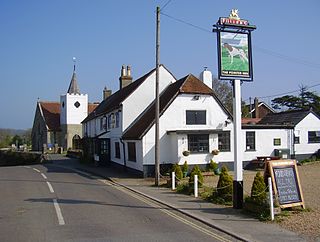
Newchurch is a village and civil parish on the Isle of Wight. It is located between Sandown and Newport in the southeast of the island. Anthony Dillington, owner of the Knighton Gorges Manor in Newchurch wrote to his son Robert in 1574 that, "This is the very Garden of England, and we be privileged to work in it as Husbandmen......." Newchurch obtained its name from the new church built in 1087 by the Norman monks of Lyra. The Newchurch Parish for many centuries stretched from the north to south coasts of the Island; by the early Nineteenth Century the growing resort towns of Ventnor and Ryde were included within its boundaries. The parish was administered by the Church Parish Vestry until 1894 when civil matters were passed to the newly formed Parish Council which now forms the second tier of Local Government under the Isle of Wight Council. In 1982 Alverstone was included in the civil parish. The present day parish includes Newchurch Village, Apse Heath, Winford, Whiteley Bank, Alverstone, Alverstone Garden Village, Queen's Bower, Princelett and Mersley.

Yarbridge is a hamlet on the Isle of Wight, England. It is at the southern tip of the parish of Brading.

Apse Heath is a hamlet on the Isle of Wight, UK. Apse Heath is centered on the intersection of Newport Road and Alverstone Road. At the 2011 Census the Post Office said the population of the hamlet was included in the civil parish of Newchurch, Isle of Wight. It is northeast of Whiteley Bank and south of Winford. Apse Heath is bordered by the leafy villages of Alverstone and Queen's Bower, and is surrounded by areas of woodland and agricultural land. It also sits roughly 2 miles east of the village of Newchurch, and 1 mile west of Lake.

Luccombe is a hamlet a short distance south of Shanklin, on the south coast of the Isle of Wight, England.

Winford is a hamlet on the Isle of Wight which since the 1950s and particularly in the late 1970s has seen considerable housing development. The local shop in Forest Road closed some time ago, but tourist attractions with gift shops are situated nearby. It is in the civil parish of Newchurch.
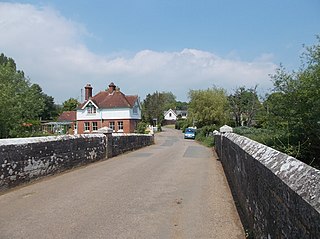
Alverstone is a village 2 miles from the east coast of the Isle of Wight, near Sandown. The name Alverstone is most likely of Saxon origin meaning "Alfred's Farm". Up until 1960, boating took place on the river and tea-gardens were very popular with local people, who came by train on excursions.
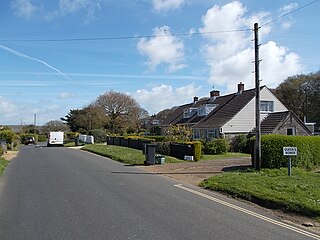
Queen's Bower is a hamlet on the Isle of Wight, England that has effectively merged with Winford and Apse Heath to create a village. It is classed as part of Sandown, with the postcode PO36. It is in the civil parish of Newchurch, Isle of Wight. Transport is provided by Southern Vectis bus route 8 to Sandown, which stops at Hairpin Bend on Alverstone Road once every hour throughout the day, which is right on the perimeter of Borthwood Copse.
Mersley is a farming hamlet on the Isle of Wight. Mersley is in Newchurch Parish, and is adjacent to the village of Newchurch itself. Mersley is home to a large garlic farm which is part of the Isle of Wight Garlic Festival in nearby Newchurch, held annually since 1983 and now drawing 25,000 visitors a year. This garlic farm has also been investigated for inappropriate pesticide use in the past.
Branstone is a hamlet on the Isle of Wight, off the south coast of England. According to the Post Office the population of the hamlet at the 2011 Census was included in the civil parish of Newchurch.

The Gorges family was a gentry family established in the southwest of England.

Sir William Russell (1257–1311) was an English nobleman, knight, and holder of a moiety of the feudal barony of North Cadbury, Somerset, but spent most of his life engaged in the administration and defence of the Isle of Wight, where he obtained by marriage the manor of Yaverland. He served as constable of Carisbrooke Castle, and sat in parliament on two occasions, firstly as burgess for Great Bedwyn, Wiltshire, and then for the County of Southampton. As a baron his military service was called on several times by King Edward I Hammer of the Scots.
Sir Robert Dillington, 1st Baronet (ca. 1575–1664) was an English aristocrat of the Dillington baronets, grandfather to Sir Robert Dillington, 2nd Baronet.
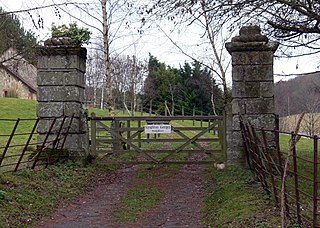
Knighton Gorges Manor was one of the grandest manor houses on the Isle of Wight, located in the hamlet of Knighton, near Newchurch.
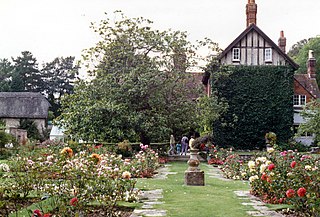
Morton Manor is a manor house originating in the 13th century, in Brading, Isle of Wight, England. It is located 1 mile (1.6 km) southwest of Sandown Road. The fairly small 14th-century house was modified in the 19th century. Constructed of varied materials, it was refurbished and extended in the early 20th century in an Arts and Crafts style. The house has a Tudor fireplace in the dining room, with William De Morgan green glazed tiles, and the manor includes a small museum of rural life.
Wackland Manor, is a manor house on the Isle of Wight, situated in the Newchurch parish. It was held in the 13th century under the Lisles of Wootton, but in 1311–12 was said to be held of Ralph de Gorges of Knighton Gorges Manor. At the end of the 13th century it was held by John de la Brigge, from whom it passed with Bridge Court (q.v.) to the Kingstons. It followed the descent of Kingston until 1424, when Robert Dingley and Lewis Meux conveyed it to John Taillour, who was returned in 1431 as holding Wackland. Its descent has not been traced from that time until the end of the 18th century. Some time before 1786 it must have been in the possession of Thomas Davis, as he left a charge of 20s. upon it for charities. In the early part of the 19th century Wackland was the residence of a hunting farmer, well known as 'Squire' Thatcher, who kept and hunted a pack of harriers. Mr. E. Carter was lord of Wackland in 1878, and as of 1912 it belonged to the trustees of the late Mr. Thomas F. Perrott.
Lieutenant-General Maurice Bocland of Knighton Gorges in the parish of Newchurch, Isle of Wight, was a British soldier and Member of Parliament.

Maurice George Bisset (1757–1821) of Knighton Gorges on the Isle of Wight, and of Lessendrum in Aberdeen, Scotland, 18th Scottish feudal baron of Lessendrum, is famous for his involvement in the scandalous court case involving his mistress Seymour Dorothy Fleming and her husband Sir Richard Worsley, 7th Baronet, of Appuldurcombe House, Isle of Wight. The case was the result of his affair with Lady Worseley, by whom he had a daughter, Jane Seymour Worsley, of whom Richard claimed paternity in order to avoid scandal.
Sir Tristram Dillington, 5th Baronet of Knighton, Isle of Wight was a British Army officer, landowner and Whig politician who sat in the House of Commons between 1707 and 1721.















